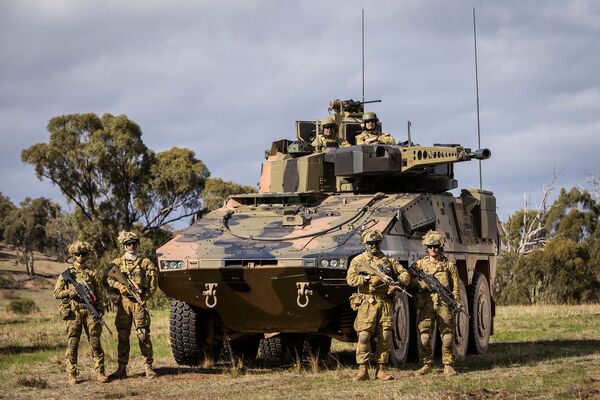
The German Army's heavy weapon carrier will be based on Austrialia's Boxer Combat Reconnaissance Vehicle, pictured with Australian Army soldiers during Exercise ‘Chong Ju' at the Puckapunyal training area, Victoria, on 16 May 2018. (Australian MoD)
The German Army's share of the EUR100 million (USD109 million) Zeitenwende special fund, approved after Russia invaded Ukraine, focuses on armoured vehicles, Janes learnt at Defence iQ's International Armoured Vehicles (IAV) 2023 conference held in London on 23–26 January.
The Bundeswehr plans to equip three new medium brigades with the heavy weapon carrier (HWC) version of the Boxer armoured vehicle in 2025–30. Based on Australia's Boxer Combat Reconnaissance Vehicle, the HWC will replace the Marder infantry fighting vehicle.
The German Army also intends to procure an airborne weapons carrier in the 2030s to replace the Wiesel. One of the new carriers would fit inside the Luftwaffe's future CH-47 heavy transport helicopter, compared with two Wiesels in the current CH-53G.
The German Army is also looking at replacing its short-range mortar carriers starting in 2027, replacing M113s remaining in service until 2030. Instead of spending seven to nine years procuring a new system, the Bundeswehr has decided to buy the self-propelled mortar version of the Common Armoured Vehicle Systems, a programme for which Germany signed a statement of intent to join in mid-2022.
Artillery to be replaced in the coming decades includes the Panzerhaubitze (PzH) 2000, with the Boxer-mounted Remote Control Howitzer (RCH) being one of the possible replacements, and the Multiple Launch Rocket System (MLRS).
The Bundeswehr is also seeking ground-based air-defence systems to quickly build up these capacities.
It is procuring Leguan armoured vehicle-launched bridges, with the possibility of being complemented by Boxer bridgelayers.
Looking to read the full article?
Gain unlimited access to Janes news and more...







